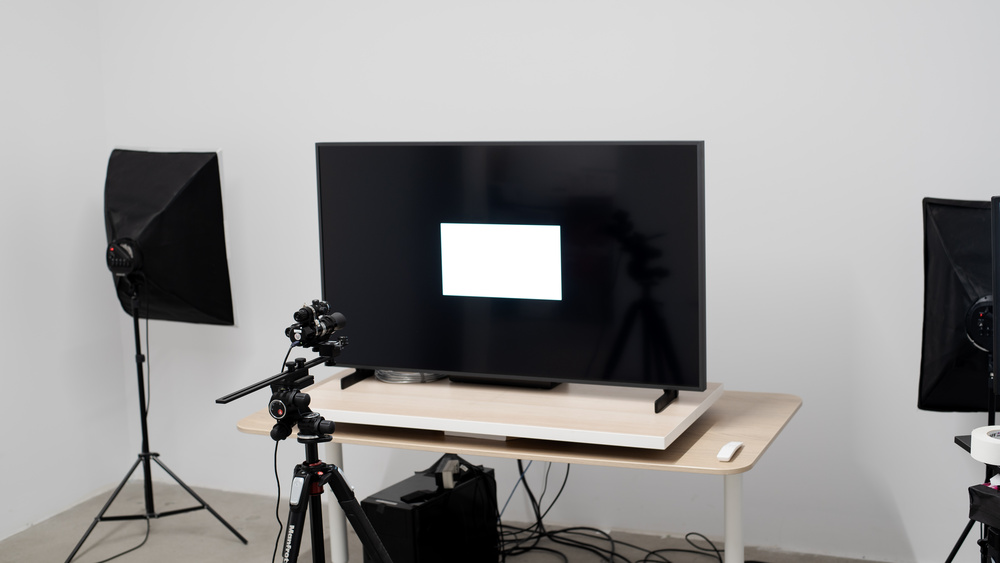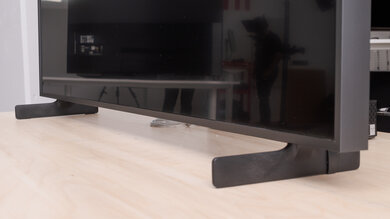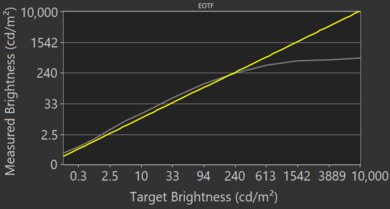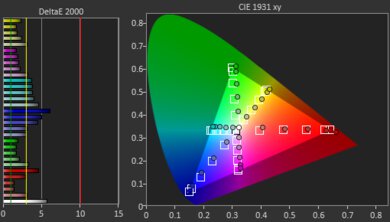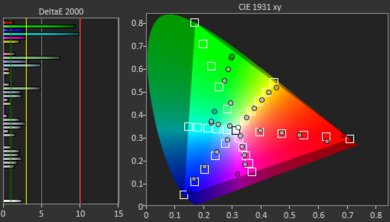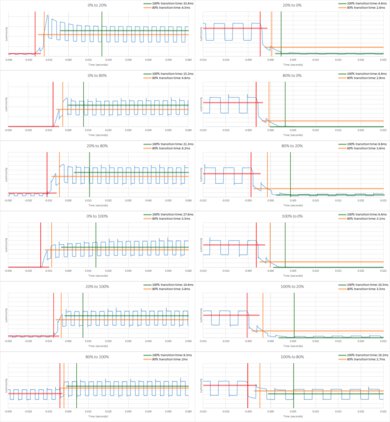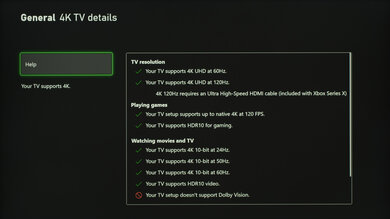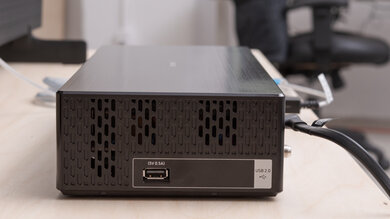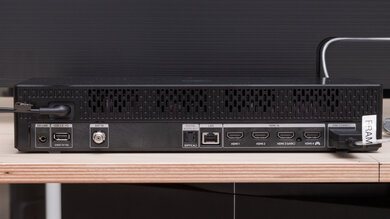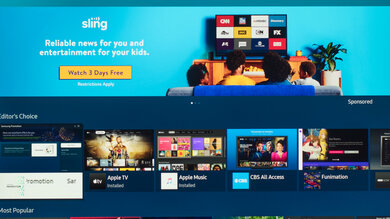Samsung The Frame 2020 is an overall good TV that's designed to blend into your decor and showcase beautiful works of art when the TV is idle. Like its predecessor, Samsung The Frame 2019, its borders are customizable and it can be wall-mounted to look like real artwork thanks to the included no-gap wall mount and the One Connect Box. It uses Samsung's QLED technology to deliver good picture quality and gamers can breathe a sigh of relief, as it still has extremely low input lag and FreeSync support. Contrast ratio and peak brightness are significantly improved in this 2020 model, making it a good choice for watching HDR content, but sadly, its viewing angles are just as poor and there's no local dimming. Nonetheless, if you're looking for a TV that stands out by blending in, this could be the one.
Our Verdict
The Frame 2020 is a good TV for most uses. It delivers good picture quality for most content, and it provides an excellent gaming experience thanks to its low input lag and VRR support. Its high contrast ratio makes it a good choice for dark room viewing, and it gets bright enough to fight glare. Unfortunately, it has rather poor viewing angles, so it's not the most ideal if your seating arrangement requires you to view from the side.
-
Exceptional contrast ratio.
-
FreeSync support.
-
Great motion handling.
-
No local dimming.
-
Poor viewing angles.
The Frame 2020 is a decent TV for watching movies. Its VA panel has a high native contrast ratio, which is great for watching in dark rooms. It can display 1080p content almost as well as native 4k, and it can remove judder from any source. Unfortunately, it doesn't have local dimming, and its poor viewing angles make it less suitable for wide seating arrangements.
The Frame 2020 is a good TV for watching TV shows. It has a great peak brightness and decent reflection handling that's well-suited for bright rooms. Lower resolution content on cable TV is upscaled well, and there's no risk of permanent burn-in if you leave it on the news all day. Its VA panel has poor viewing angles, though, which makes it less ideal if you like doing chores or walking around while watching.
The Frame 2020 is a good TV for watching sports. Motion handling is great, so there are only short blur trails in fast-moving scenes, and there's very little dirty screen effect, which is great. Reflection handling is decent and the TV can get bright enough to overcome glare in any type of room setting. However, it's not the best choice for watching with a large of people, as its VA panel has poor viewing angles.
The Frame 2020 is an impressive TV for gaming. It has a low input lag that makes every button press feel incredibly responsive, and it supports variable refresh rate technologies like FreeSync and HDMI Forum's VRR. Its 120Hz refresh rate and fast response time make motion look silky smooth, and its high contrast ratio is great for gaming in the dark.
The Frame 2020 is a decent TV for watching HDR movies. Its VA panel has an exceptional contrast ratio and excellent black uniformity to produce deep blacks, but unfortunately, it doesn't have local dimming to further improve it. It can display a wide color gamut to produce vibrant and vivid colors, and it gets decently bright to bring out highlights when watching in a dark room. However, its peak brightness isn't enough to make HDR content look significantly better than SDR in well-lit environments.
The Frame 2020 is a good TV for gaming in HDR. It has an extremely low input lag, and it remains low even when playing in 4k with 10-bit HDR. Response time is great, so fast motion looks crisp, and there's even an optional black frame insertion feature to further improve motion clarity. Its exceptional contrast ratio makes it a fantastic choice for gaming in the dark, and the TV can deliver a good HDR experience thanks to its great color gamut and decent HDR peak brightness.
The Frame 2020 is a good TV for use as a PC monitor. Thanks to its chroma 4:4:4 support and 4k resolution, text looks incredibly sharp. Input lag is low and response time is fast, which results in a responsive desktop experience. Its viewing angles are poor, so the image can look washed out at the sides if you sit too close, but on the bright side, its VA panel is immune to permanent burn-in.
- 7.5 Mixed Usage
- 7.1 Movies
- 7.7 TV Shows
- 7.6 Sports
- 7.9 Video Games
- 7.1 HDR Movies
- 7.8 HDR Gaming
- 8.0 PC Monitor
- Updated Jul 27, 2021: Added the real content local dimming videos and retested the 4k @ 120Hz with chroma 4:4:4 support.
- Updated Mar 01, 2021: Converted to Test Bench 1.6.
- Updated Nov 27, 2020: We've retested the VRR, input lag, and supported resolutions with an HDMI 2.1 source and the latest firmware version 1403.
- Updated Oct 06, 2020: We've changed the status of the Auto-Calibration function from 'Untested' to 'Undetermined'.
- Updated Aug 21, 2020: We've retested the TV and concluded that it doesn't have any sub-pixel dimming, dithering, or crosshatching. The score has been adjusted.
- Updated Aug 19, 2020: Update to HDMI Forum VRR support.
- Updated Jul 07, 2020: The TV's native refresh rate wasn't previously indicated. It has been fixed.
- Updated Jun 02, 2020: Converted to Test Bench 1.5.
- Updated Jun 02, 2020: Review published.
- Updated May 28, 2020: Early access published.
- Updated May 12, 2020: Our testers have started testing this product.
- Updated Apr 14, 2020: The product has arrived in our lab, and our testers will start evaluating it soon.
- Updated Feb 28, 2020: We've purchased the product and are waiting for it to arrive in our lab.
Differences Between Sizes And Variants
We tested the 55" (QN55LS03TA) variant of The Frame 2020, and for the most part, we expect our review to be valid for the 43" (QN43LS03TA), the 50" variant (QN50LS03TA), the 65" variant (QN65LS03TA), and the 75" variant (QN75LS03TA). The 32" model has a 1080p resolution and we haven't tested it, so our review is less applicable.
If someone comes across a different type of panel or if their Samsung Frame 2020 doesn't correspond to our review, let us know and we will update the review. Note that some tests such as the gray uniformity may vary between individual units.
| Size | US | Canada | UK | Italy | Germany | Refresh rate | Notes |
|---|---|---|---|---|---|---|---|
| 32" | QN32LS03TBFXZA | QN32LS03TBFXZC | QE32LS03TBKXXU | QE32LS03TBKXZT | GQ32LS03TBKXZG | 60Hz | 1080p, no VRR |
| 43" | QN43LS03TAFXZA | QN43LS03TAFXZC | QN43LS03TAUXXU | QE43LS03TAUXZT | GQ43LS03TAUXZG | 60Hz | FreeSync |
| 50" | QN50LS03TAFXZA | QN50LS03TAFXZC | QN50LS03TAUXXU | QE50LS03TAUXZT | GQ50LS03TAUXZG | 60Hz | FreeSync |
| 55" | QN55LS03TAFXZA | QN55LS03TAFXZC | QN55LS03TAUXXU | QE55LS03TAUXZT | GQ55LS03TAUXZG | 120Hz | FreeSync, HDMI Forum |
| 65" | QN65LS03TAFXZA | QN65LS03TAFXZC | QN65LS03TAUXXU | QE65LS03TAUXZT | GQ65LS03TAUXZG | 120Hz | FreeSync, HDMI Forum |
| 75" | QN75LS03TAFXZA | QN75LS03TAFXZC | QN75LS03TAUXXU | QE75LS03TAUXZT | GQ75LS03TAUXZG | 120Hz | FreeSync, HDMI Forum |
Our unit of The Frame 2020 was manufactured in March 2020, you can see the label here.
Compared To Other TVs

The Samsung The Frame 2020 is an overall good TV. However, unless you specifically want its Art Mode feature or its One Connect Box for gapless wall-mounting, there are better TVs that are significantly cheaper. Compared to other Samsung QLED TVs, The Frame 2020 sits between the Samsung Q70T QLED and the Samsung Q80T QLED. For other options, you can also check out our recommendations for the best TVs, the best 4k HDR TVs, and the best 4k gaming TVs.
The Samsung The Frame 2020 and the Samsung The Frame 2022 QLED are similar TVs. The main difference is that the 2022 model has a matte screen finish that makes the TV look more like a piece of art, and it has much better reflection handling. It also has better out-of-the-box accuracy, and it has improved gradient handling.
The Samsung The Frame 2021 is the successor to the Samsung The Frame 2020. They perform similarly for the most part; however, the 2020 model has a much higher contrast ratio and a better color gamut. The 2021 model has slightly better response times, and its backlight flickers at a much higher frequency, resulting in less image duplication in fast-moving content.
The Samsung The Frame 2020 and the Samsung Q70/Q70T QLED perform similarly overall. The biggest difference is that the Frame is designed to look like a framed piece of art, so if you're looking for a TV with a unique design, it may be the better option. However, if you're looking for a standard TV, and you can forgive the slower response time, the Q70T may be preferable.
The LG CX OLED is a significantly better TV than the Samsung The Frame 2020. Being an OLED TV, the LG can produce perfect blacks, which the Frame 2020 can't do. The LG has a faster response time, wider viewing angles, and its reflection handling is much better too. It has better color accuracy as well; however, the Frame has a lower input lag and it gets brighter in SDR.
The Samsung The Frame 2020 is a very decent upgrade from the Samsung The Frame 2019. Aside from some minor differences in their outer design, the 2020 has a much higher contrast ratio and peak brightness. Input lag is also lower on the 2020; however, it's not as color accurate. There's some improvement in terms of black and gray uniformity, but this could be due to panel variance.
The Samsung The Frame 2020 is a bit better overall than the Samsung Q60/Q60T QLED, but they're designed for different uses. The Frame is very well-built because it's designed to look like a piece of art. It's also better for gaming thanks to its HDMI 2.1 and VRR support, which the Q60T doesn't have, but that's only available on the larger sizes of The Frame. In terms of picture quality, each TV is similar with a high native contrast ratio and great SDR peak brightness.
Overall, the Samsung Q80/Q80T QLED performs better than the Samsung The Frame 2020. The Q80T has wider viewing angles due to its 'Ultra Viewing Angle' layer, but it also gives it a much lower contrast ratio than that of the Frame 2020, making blacks look a bit more grayish. The Q80T has significantly better reflection handling, much better color accuracy, and can get brighter in HDR. Also, the Q80T has local dimming, unlike the Frame 2020.
The LG GX OLED and the Samsung The Frame 2020 are two TVs that come with a wall mount and are designed to sit flush against a wall. The LG is better overall because it's much thinner, it has an infinite contrast ratio, much wider viewing angles, and G-SYNC support. However, the Samsung gets brighter in HDR, it has lower input lag, and it doesn't have the risk of permanent burn-in.
Overall, the Samsung The Frame 2020 is much better than the Samsung The Sero. The Frame has a much higher contrast ratio, faster response time, and it gets a lot brighter. It also has a 120Hz refresh rate and VRR support to reduce screen tearing when gaming. However, the Sero's IPS panel has wider viewing angles and better color accuracy.
Overall, the Samsung The Terrace is much better than the Samsung The Frame 2020. However, they're meant for different uses. The Terrace is an outdoor TV with significantly higher peak brightness, better reflection handling, and a full-array local dimming feature. On the other hand, The Frame 2020 has FreeSync support to reduce screen tearing when gaming, and it comes with the One Connect Box, which is great for keeping your setup clean.
Test Results
The Frame 2020 has an outstanding design. It's very similar to its predecessor, Samsung The Frame 2019, with only a few changes to the stand and the back. It still has the One Connect box, so there's only a single cable leading up to the TV, which is great for a clean setup. The bezels are thin on all sides and there's no Samsung branding anywhere on the front. It supports Samsung's no-gap wall mount, which comes included in the box.
The back of the TV is fairly plain and has a fine horizontal texture etched into it. There's only a single cable leading up to the TV since all the inputs are located on the One Connect Box. There's a small groove that serves as cable management, guiding the One Connect cable towards the bottom of the TV. It supports Samsung's no-gap wall mount and one is included in the box. Unfortunately, there aren't any panels to hide the mounting holes when the TV is on the stand.
The Frame 2020 has a boxy side profile that's intended to look like the frame of real artwork. When using the included no-gap wall mount, it sits flush to the wall and doesn't stick out much.
We noticed that our unit leans slightly backward when it's mounted on the stand; we're not sure if this is a manufacturing defect or if it was damaged during shipping. Your experience may vary.
Outstanding build quality. Although it's mostly plastic, the TV feels very well-built and there are no obvious issues. The TV wobbles a bit and our unit leans backward when it's mounted on the stand; however, this TV is meant to be wall-mounted, as the mounting accessories are even included in the box.
Impressive SDR peak brightness. It's remarkably consistent across different content, except for the 2% window being much dimmer due to the TV's CE dimming (frame dimming). It's enough to overcome glare even in very bright rooms.
We measured the peak brightness after calibration, using the 'Movie' mode and with Brightness set to maximum.
Update 07/27/2021: Added the real content local dimming videos.
The Samsung Frame 2020 doesn't have a local dimming feature. The videos are for reference only, so you can see how backlight on this display performs and compare it to a similar product with local dimming.
Update 07/27/2021: Added the real content local dimming videos.
Once again, it doesn't have a local dimming feature. The videos are for reference only, so you can see how backlight on this display performs and compare it to a similar product with local dimming.
Decent HDR peak brightness. It doesn't get much brighter than SDR and the 2% window is also dimmer, but it's also very consistent. It can deliver a good HDR experience in dark rooms; however, it won't look much different from SDR in bright environments.
We measured the HDR peak brightness before calibration, using the 'Movie HDR' mode and the 'Warm 2' Color Temperature. Brightness and Contrast were set to maximum.
Decent reflection handling. Visibility shouldn't be an issue in most rooms, but best to avoid having light shining directly on the screen, as the reflection can be distracting. The newer Samsung The Frame 2022 QLED has a matte finish meant to reduce the amount of direct reflections and make the artwork look more realistic, if that's what you prefer.
The Frame 2020 has decent color accuracy out of the box. There are inaccuracies with several colors and white balance is off. The 'Warm 2' Color Temperature is warmer than our 6500K target, which results in a slight reddish tint. Gamma doesn't follow the target at all; most scenes are too bright and dark scenes are darker than they should be.
Update 10/06/2020: We've changed the status of the Auto-Calibration function from 'Untested' to 'Undetermined', as the Samsung The Frame 2020 isn't yet listed as being compatible with CalMAN.
After calibration, color accuracy is exceptional. White balance and gamma are nearly perfect, and the color temperature is much closer to our target. There are still some inaccuracies with reds and blues, but the rest shouldn't be noticeable for most people.
You can see our recommended settings here.
Update 08/21/2020: We previously reported that there's sub-pixel dimming and dithering, as well as some crosshatching. This is incorrect. The picture that we used has some crosshatching by default, and there are no signs of dimming or dithering. The score has been adjusted accordingly.
Native 4k content is displayed perfectly.
The 32" model has a 1080p resolution and can't display a 4k image.
Update 08/21/2020: We previously reported that there's sub-pixel dimming and dithering, as well as some crosshatching. This is incorrect. The picture that we used has some crosshatching by default, and there are no signs of dimming or dithering.
This TV uses a BGR sub-pixel layout. It doesn't affect picture quality but can affect text clarity when using the TV as a PC monitor. You can read more about it here.
The Frame 2020 has a great color gamut. Coverage of the widely used DCI P3 is excellent, and coverage of the wider Rec 2020 color space is decent. The 'Movie' EOTF follows the target quite well until the roll-off, and it's similar in 'Game' mode, although a bit brighter, as you can see in this EOTF.
If you find HDR content too dim, you can make it brighter by setting Contrast Enhancer to 'High', which results in this EOTF.
The Frame 2020 has great gradient handling. There's only some minor banding in reds and greens. If banding bothers you, enabling Digital Clean View can remove most of it, but can also cause the loss of fine details in some scenes.
We don't expect VA panels to experience permanent image retention, as the VA panel in our long-term test appears immune.
The Frame 2020 uses PWM to dim its backlight. It normally flickers at 240Hz, but the frequency drops to 120Hz when Picture Clarity is enabled, even if you don't adjust the Blur and Judder reduction sliders. Enabling LED Clear Motion lowers the flickering frequency further to 60Hz.
Note that every picture mode except 'Movie' mode has Picture Clarity enabled by default.
If the flickering bothers you, check out the Samsung The Frame 2021. It has a much higher flicker frequency, which should be less noticeable.
The Frame 2020 has an optional black frame insertion feature that can help reduce motion blur, called LED Clear Motion. It causes a bit of duplication, but still an improvement from the Frame 2019. To use it in 60fps content, simply enable LED Clear Motion. For 120fps content, only enable Picture Clarity without adjusting any sliders.
If you want to use this feature when gaming, it's the same step but within the Game Motion Plus settings menu. For games that normally run at 60fps, enable LED Clear Motion, and for games that run natively at 120fps, enable Picture Clarity in any picture mode with 'Game' mode on.
The Frame 2020 can interpolate lower frame rate content up to 120Hz, otherwise known as the 'Soap Opera Effect'. It looks good generally, but there are visible artifacts in intense scenes. To use it, first enable Picture Clarity, then set the Judder Reduction slider to '10' for 30fps content, or set the Blur Reduction slider to '10' for 60fps content.
This feature can also be used when gaming. Simply enable Picture Clarity within the Game Motion Plus settings menu, then set the Judder Reduction slider to '10' for games that normally run at 30fps, or the Blur Reduction slider for games that run at 120fps natively.
There seems to be a bug that's causing the Blur Reduction slider to not affect 30fps content. It may get fixed in a future firmware update, and we'll provide an update once we've tested it.
Although the Frame 2020 has a fast response time, it doesn't cause too much stutter in low frame content. It can still happen in some scenes and if it bothers you, enabling Picture Clarity can help.
This TV can remove judder from all sources. To do so, set Picture Clarity to 'Custom' but leave the Judder and Blur reduction sliders at '0'.
Update 07/27/2021: We updated the firmware to version 2016, and it doesn't have any issues displaying 4k @ 120Hz content with chroma 4:4:4, including in Game Mode.
Update 11/27/2020: We've retested the VRR with an HDMI 2.1 source and the latest firmware (version 1403).
Update 08/19/2020: We changed HDMI Forum VRR to 'Unknown' because we currently don't have an accurate way to test for HDMI Forum VRR compatibility. Once we do, we'll test for it and update the review.
Update 07/07/2020: We had neglected to indicate the native refresh rate of the TV for comparison purposes. It is now fixed.
The Frame 2020 supports FreeSync to reduce screen tearing when gaming. However, the 32 inch model doesn't have any VRR support. Additionally, the 32", 43", and 50" sizes have a 60Hz panel, instead of the 120Hz on the larger variants.
Do note that FreeSync only works on the HDMI 4 port. Although the TV states that FreeSync is enabled and working when using another HDMI port, there was still a significant amount of tearing in-game. Furthermore, even on HDMI 4, it was inconsistent but usable. Turning the TV off and back on or restarting the computer can sometimes resolve the issue.
Update 11/27/2020: We've retested the input lag with an HDMI 2.1 source and the latest firmware (version 1403).
The Frame 2020's input lag is outstanding. It's extremely low as long as you're in 'Game' mode, and PC users only need to be in 'PC' mode to get the lowest latency. The input lag does increase when playing with 10-bit HDR, VRR, or Game Motion Plus, but the difference is so small that most people shouldn't notice it.
Update 07/27/2021: We updated the firmware to version 2016, and it doesn't have any issues displaying 4k @ 120Hz content with chroma 4:4:4, as it was skipping frames before the update.
Update 11/27/2020: We've retested the supported resolutions with an HDMI 2.1 source and the latest firmware (version 1403).
The Frame 2020 supports most common resolutions and can display proper chroma 4:4:4 at all resolutions, except 1440p@120Hz. To display chroma 4:4:4, the input in use must be labelled 'PC', and for high bandwidth signals, Input Signal Plus must be enabled.
The 32" model has a 1080p resolution.
Update 07/27/2021: We updated the firmware to version 2016, and it doesn't have any issues displaying 4k @ 120Hz content in HDR from the PS5; it couldn't do it before the update.
The Frame 2020 supports eARC, allowing you to send high-quality object-based audio like Dolby Atmos via TrueHD over an HDMI connection. To use, eARC must be set to 'Passthrough'.
The Frame 2020 has a mediocre frequency response. It's reasonably well-balanced overall and the bass has a good amount of punch; however, there's not enough bass extension to produce any rumble or thump. It gets loud enough for large or noisy rooms, but there are quite a bit of compression artifacts at max volume.
Like all Samsung TVs, the Frame 2020 runs on Tizen OS. It's easy to use and runs very smoothly. We didn't encounter any overscan bugs, which we had observed on other Samsung TVs, likely because the TV was already set to 16:9 aspect ratio by default.
Samsung's app store has a wide selection of apps and you should be able to find what you need. As the name of the TV suggests, one of the highlight features is its Art Mode. It displays artwork or photos when the TV is in standby mode, which you can start by pressing the power button on the remote. You can learn more about Samsung's Art Mode here.
The remote control is the same one that comes with The Frame 2019. There are very few buttons, just enough to navigate the Smart Hub and to change settings like volume and channel. There are also some shortcuts to popular streaming services and a built-in microphone for voice control. The remote can be used as a universal remote control for other devices, even if the device doesn't support CEC.
When it comes to voice control, it's a bit of a hit or miss. You can ask for general info like the time or weather, and to change TV settings such as the input source or brightness. We were able to search for content on YouTube, but not in Netflix.

